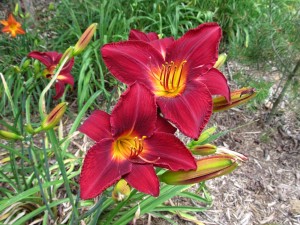In the gardening world new does not always mean better. Red Volunteer daylily (Hemerocallis x ‘Red Volunteer’) is not new, introduced by Oakes Daylily Nursery, near Knoxville, TN in 1984. Daylily catalogs describe it as a “candle red self with a golden yellow throat”. It is a mid-season bloomer and the foliage is semi-evergreen.
The 7- inch diameter blooms stand 30 inches tall, not hidden inside the grass-like daylily foliage as some varieties do. Its vivid red flowers are real standouts. The red color does not fade in the summer sun, as red at 5 p.m. as it was at 8 a.m. in the morning. The color of many red daylily varieties is washed out by noon
Red Volunteer is a good multiplier, a rapid clump producer. A 2-3 year old well-grown plant may form 8 or more floral scapes, each with a dozen buds. Red Volunteer does not need to be divided every 5 years.
Red Volunteer blooms in mid- to late June in the Southern Appalachian region (USDA hardiness zones 6 and 7). While preferring a moist, compost rich, well drained soil, it grows well in a heavy clay soil. Once established in a garden for one year, Red Volunteer exhibits exceptional summer heat and drought tolerance. Its long grass-like foliage stays green and lush when adequately watered and fertilized.
Daylilies are mostly disease and insect resistant. Aphids and thrips, as well as slugs and snails, may cause minor damage to the foliage.
Red Volunteer was awarded the AHS Award of Merit in 1994.


 Posted in
Posted in 
